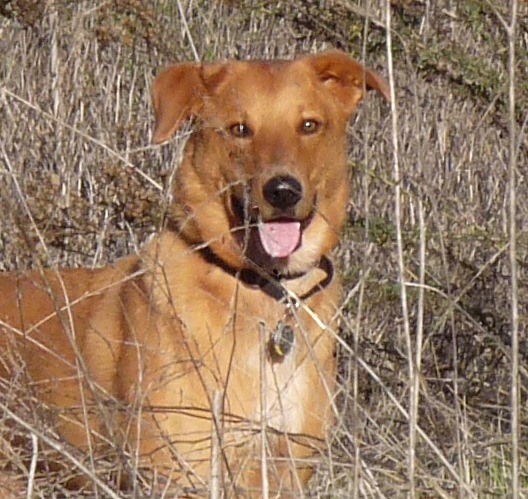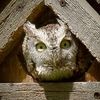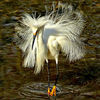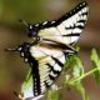How to meter for white birds.
This topic is locked to prevent further replies.
Aug 13, 2013 15:31:41 #
Have you ever taken a picture of a Snowy Egret only to find out that all the feather detail in the highlights is gone? Have you ever taken a picture of a Great Egret only to find that it showed up as gray and didnt look at all like you saw it? If so, your light meter has been tricked!
Modern cameras, despite the complex electronics and focus and exposure algorithms that they have, can still be fooled by snow scenes, white bridal gowns and white birds! We photographers need to learn to recognize when this is likely to happen and make adjustments accordingly.
Why does this happen? Light meters take the information that they receive in terms of light values and try to render it as middle gray. To test this for yourself, take and photograph a piece of evenly lit white paper. Fill the frame with it and expose properly according to the light meter. Auto is perfectly OK even if you use flash. Look at the picture on the LCD. I can guarantee it wont be bright white!
How we apply this to the real world depends on whether we are spot metering or using one of the averaging or evaluative modes.
When we use a spot meter, the camera only sees a very small part of the scene, usually less than 3% at the center of the viewfinder. Most cameras will have a small circle to show you where it is. Since the white bird is all that this spot sees, it will give us middle gray unless we increase exposure by 1 or 2 stops. In any of the automatic modes, we use + exposure compensation. We must remember, though, that the spot must either remain on the bird or we must meter our exposure, lock it and recompose. If using manual exposure, we adjust f/stop, shutter speed or ISO to achieve the same thing.
If we are using one of the averaging meter modes, Center Weighted Average, Matrix, Evaluative etc, it can get a little more complex. If the white bird takes up about half of the viewfinder then we may not need to do any compensation. If the bird is less than half then we can find the bird overexposed and we need to dial in some negative exposure compensation. This tendency will increase as the bird takes up less and less space in the viewfinder or if the background is very dark.
This is where I recommend that you use the Blinkies. Most cameras will allow you to turn on a highlight alert that will cause overexposed areas of the photo to flash when you view the picture on the LCD. So, you take a picture, take a quick look, and adjust exposure down enough to avoid the blinkies. How much? Usually 1 to 2 stops. If you pay attention, you will soon learn to recognize when it is likely that your meter will be fooled and be able to react before you lose that cover shot!
Modern cameras, despite the complex electronics and focus and exposure algorithms that they have, can still be fooled by snow scenes, white bridal gowns and white birds! We photographers need to learn to recognize when this is likely to happen and make adjustments accordingly.
Why does this happen? Light meters take the information that they receive in terms of light values and try to render it as middle gray. To test this for yourself, take and photograph a piece of evenly lit white paper. Fill the frame with it and expose properly according to the light meter. Auto is perfectly OK even if you use flash. Look at the picture on the LCD. I can guarantee it wont be bright white!
How we apply this to the real world depends on whether we are spot metering or using one of the averaging or evaluative modes.
When we use a spot meter, the camera only sees a very small part of the scene, usually less than 3% at the center of the viewfinder. Most cameras will have a small circle to show you where it is. Since the white bird is all that this spot sees, it will give us middle gray unless we increase exposure by 1 or 2 stops. In any of the automatic modes, we use + exposure compensation. We must remember, though, that the spot must either remain on the bird or we must meter our exposure, lock it and recompose. If using manual exposure, we adjust f/stop, shutter speed or ISO to achieve the same thing.
If we are using one of the averaging meter modes, Center Weighted Average, Matrix, Evaluative etc, it can get a little more complex. If the white bird takes up about half of the viewfinder then we may not need to do any compensation. If the bird is less than half then we can find the bird overexposed and we need to dial in some negative exposure compensation. This tendency will increase as the bird takes up less and less space in the viewfinder or if the background is very dark.
This is where I recommend that you use the Blinkies. Most cameras will allow you to turn on a highlight alert that will cause overexposed areas of the photo to flash when you view the picture on the LCD. So, you take a picture, take a quick look, and adjust exposure down enough to avoid the blinkies. How much? Usually 1 to 2 stops. If you pay attention, you will soon learn to recognize when it is likely that your meter will be fooled and be able to react before you lose that cover shot!
Aug 14, 2013 00:35:03 #
Thanks so much for posting this. I have been having a lot of trouble with whites.
One thing that I need to have clarified please...by increasing exposure 1 or 2 stops do you mean resetting the f/stop to open it more? I've never been clear on the meaning of this phrase and how I should make the adjustment. I've played around with ISO and shutter speed to try to get the right exposure, but I honestly don't know what I'm doing. Maybe I need to read "Understanding Exposure" again. Any ideas?
One thing that I need to have clarified please...by increasing exposure 1 or 2 stops do you mean resetting the f/stop to open it more? I've never been clear on the meaning of this phrase and how I should make the adjustment. I've played around with ISO and shutter speed to try to get the right exposure, but I honestly don't know what I'm doing. Maybe I need to read "Understanding Exposure" again. Any ideas?
Aug 14, 2013 01:12:56 #
vicksart wrote:
Thanks so much for posting this. I have been havin... (show quote)
The word "stop" here is a generalized term that is used to denote the halving or doubling of the light or ISO. that means that you could change any of the three legs of the exposure triangle to achieve this increase. For example, if your meter gave you a reading of f/11 and you wanted to increase exposure you would go to f/8 for one stop and f/5.6 for two stops more. If your shutter speed was 1/1000 and you wanted to increase exposure you would go to 1/500 for one stop and 1/250 for two stops more. Using ISO you could increase from 100 to 200 for one stop and to 400 for two stops. NOTE: These adjustments will only work in full manual exposure mode.
If you are in any of the automatic modes, let's say Aperture priority, and increase your aperture two stops the camera will automatically adjust the shutter speed 2 stops to maintain the same exposure level you started with so you won't get any increase in light. In this case you use Exposure Compensation to tell the camera to add two stops of exposure to the metered reading. The camera would then automatically adjust the shutter speed to accomplish this. Using the Exposure Compensation menu you would dial in +1 or +2 EV. ( EV or Exposure Value is the same as a "stop")
Yes, reread Brian Petersen's book. It is one of the best on the market. I'll be happy to answer any other questions you may have.
Aug 14, 2013 20:17:08 #
birdpix wrote:
The word "stop" here is a generalized te... (show quote)
Thanks so much for your explanation. This information really helps and is very much what I thought. Now...off to see if I can make it all work!
Aug 16, 2013 22:17:20 #
Aug 16, 2013 22:24:23 #
mollymolly wrote:
Does the 7D have a highlight alert?
Yup, it sure does, Molly. It's in the 6th menu from the right, or left.
Aug 16, 2013 22:31:04 #
birdpix wrote:
Yup, it sure does, Molly. It's in the 6th menu from the right, or left.
Thanks!!
Oct 15, 2013 01:51:49 #
mollymolly wrote:
Thanks!!
Love your avatar.
Our rescue dog, Rusty, from Mississippi to a San Diego shelter

Oct 15, 2013 17:30:15 #
wings42 wrote:
Love your avatar.
What a handsome fellow!! And that happy smile melts my heart! Shelter animals are some of the most deserving and the most appreciative of rescues. Thank you for giving this one his chance at a Forever, loving home!
If you want to reply, then register here. Registration is free and your account is created instantly, so you can post right away.



